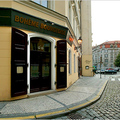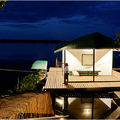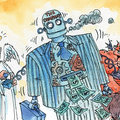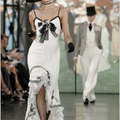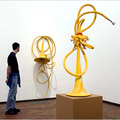IN the former East Berlin, directly across from the Marx-Engels-Forum — where immense statues of Karl and Friedrich seem to sit in stern judgment of the city — you might stumble across the Alt-Berliner Weissbierstube, a cozy cafe specializing in Berliner weisse, the city's classic local beer.
There, wide goblets of weisse are doctored with shots of syrup before serving: most commonly green, made from woodruff, a fragrant forest herb; or red, made from raspberries. Both have the effect of coloring the drink a garish jade or vermillion, and both are said to make it cloyingly sweet.
When a waitress came by to take my order, I asked if I could try the beer without the accompanying syrup.
“You could, but it's very sour,” she said.
She was right: it was bitingly sour, partly from the unusual use of lactobacillus in fermentation, the same type of bacteria that produce yogurt, in addition to the regular brewer's yeast. After a very light sweetness in the mouth, there was a sharp, yogurt-like sour finish that made the drink surprisingly refreshing.
I asked for another.
Dynamic, bustling Berlin may be many things — an Old World capital of cool, the home of a vibrant literary and artistic community, Eurotrash style central — but it is not generally thought of as a city with great beer. And yet just 200 years ago, Napoleon's army celebrated its occupation of Berlin with big mugs of weisse, toasting victories with a light, golden elixir that the French hailed as “the Champagne of the North.”
Back then, there were said to be some 700 brewers of weisse in Berlin. Today, the number is rapidly approaching zero, with the last two major producers, Kindl and Schultheiss, recently coming under the same ownership.
Thus the rub: though Germany is home to some of the greatest beer culture on the planet, local flavor is increasingly elusive. Ever since the rise of lagers like Pilsener and the spread of industrial brewing in the late 19th century, dozens, if not hundreds, of charismatic local beers have disappeared.
“It happened very quickly,” said Ron Pattinson, whose European Beer Guide lists many obsolete and rare German beers, including broyhan from Hannover, mumme from Braunschweig and keut from Münster. “The older styles were overwhelmed, and what we've got left are just the odd remnants of beers. It's like a landscape that has been swamped, and you can just make out the odd tree and hilltop.”
This spring, I decided to make a journey to some of these remaining trees and hilltops in search of a few local beers that had not vanished. I wanted to try those German brews that had maintained a sense of local flavor, beers that were produced in their hometowns and, more or less, nowhere else.
In Cologne, I would drink Kölsch, a light and fruity pale ale, one of the few beers protected by an appellation of origin as if it were a wine. In Leipzig, I would seek out Gose, a spiced amber beer that was out of production for two decades and that is just now making a small comeback. And in Bamberg, I would try the elusive rauchbier, a beer made with wood-smoked malt that is said to taste like liquid bacon.
Other beer pilgrims could have just as easily chosen other cities with great brewing histories — Düsseldorf, Dortmund and Munich come to mind — but my trio seemed to offer the most promise and variety.
WITHIN a day of my introduction to Berliner weisse, I was whizzing across Germany toward Cologne via the high-speed Deutsche Bahn, the German rail system, traveling faster than many of the cars on the autobahn outside. There, after booking into a hostel in the center of town, just minutes from the Dom, Cologne's massive cathedral, I set out in search of my first Kölsch.
I found it at Brauerei Päffgen, a traditional wood-on-more-wood tavern on a narrow lane just outside the Old Town. But drinking a Kölsch is more than just drinking a beer: it's like drinking an entire culture.
By German law, only beers brewed in Cologne may be called Kölsch, and they must be served in the tall, cylindrical glasses called stange. The Kölsch waiter, known as a Köbes, is almost always clad in blue and is universally known for a sharp tongue. (Request a glass of water instead of beer and your Köbes will probably ask if he should bring soap and a towel, too.)
I managed to get my first Kölsch without much hassle, handed over by a burly Köbes swinging the traditional round tray called a kranz, or wreath. The beer was not unlike a Pilsener in color, but the taste was much less bitter, with a nice grassy note in the mouth and a delicate fruitiness to the finish. I had more trouble getting the second, and when it came, I noticed the Köbes brusquely called me “du,” the informal word for “you” that an adult might use to address a child.
“The Köbes is always like that,” the man sitting next to me said. His name was Guenther Herrmann and he told me that once, sitting in a pub, he had tried to move his chair out of a ray of direct sunlight, “and the Köbes said, ‘No! The chair stays here!' ”
Traditional décor and traditionally gruff waiters are obviously part of the charm for the older Cologne residents I kept encountering: while visiting Schreckenskammer, a Kölsch pub near the hostel, I calculated the average age as roughly 73 ½. Ditto the historic Kölsch pub Früh, down near the cathedral. But what about local beer fans who were not yet drawing a pension?
I got the answer while struggling with my map outside the city's wondrous Chocolate Museum, which sits directly on the banks of the Rhine. A young woman stopped and offered directions. After we figured out where I was going, I asked if she drank Kölsch.
“All the time,” she said.
If I was interested in beer, she asked, would I like to go on a Kölsch crawl with her and a few of her girlfriends?
Twelve years after college, all those German classes finally paid off. That night I met the woman, Mira, and two of her fellow university students at Scheinbar, a cool lounge in the upscale Belgisches Viertel neighborhood. The crowd, a mix of gay and straight, youngish and younger, was mostly sipping cocktails, though several people held the distinctive narrow Kölsch glasses.
Why beer, in such a slick place? And why Kölsch?
“We're proud of it,” Mira said. “I'm not necessarily proud of being German, but I am proud of being from Cologne. This is our beer.”
In fact, Kölsch seemed to be a favorite of all the cool kids. Just around the corner from the venerable Päffgen, Mira and her girlfriends took me to Päff, a sister bar. Where Päffgen was all about Old Cologne, Päff typified the new one: a packed club playing hip-hop at high volume while a diverse crowd partied with glasses of Päffgen Kölsch.
If my presence had brought the average age down in Schreckenskammer, it had certainly raised it in Päff. But it was dark, loud and fun enough that no one seemed to notice.
The next day, after a five-hour trip on a Deutsche Bahn Inter-City Express, I was in Leipzig, standing in St. Thomas Church, where Johann Sebastian Bach worked as cantor and director of music from 1723 to 1750. During Bach's tenure, Leipzig started to become famous for something other than great melodies: Gose, a deep orange brew flavored with salt and coriander.
This gave rise to the Gosenschenke, a type of Gose specialty bar that was once found throughout the city. Not long after World War II, however, with Leipzig on the other side of the Iron Curtain, Gose production wavered, then stopped entirely.
But then a Gosenschenke called Ohne Bedenken reopened in 1986, serving the city's first real Gose in almost 20 years, followed by a new Gose brewpub, Bayerischer Bahnhof, which opened in a magnificent former train station just around the turn of the millennium. Another Gose, Ritterguts, is now being made just outside of town. And Gose partisans have even organized a Gose-wanderweg trail for hiking from one Gosenschenke to the next, leading from Leipzig to the town of Halle along the Pleisse, Weisse Elster and Parthe Rivers.
In the theater district just steps from the site of the great Leipzig synagogue that was destroyed on Kristallnacht, now the site of a chilling Holocaust memorial, I found Sinfonie, a dark cafe-restaurant with Ritterguts and “things to go with Gose” on the menu. I decided on a half-liter of Gose with a pairing of pan-fried zander and salmon accompanied by lemon sauce and a warm cucumber salad.
The Gose was amazing, with a mild taste of salt immediately noticeable in its thick, mousse-like head. Its body was light and slightly spicy followed by a remarkably bright finish — more crisp than the most crisp riesling, sharper than the sharpest Chablis, and a better match for tricky citrus and vinaigrette than any wine I'd ever encountered.
The next day, at Ohne Bedenken, I tried both Ritterguts and Bayerischer Bahnhof beers with roast pork and sauerkraut, another notorious trap for wine. Both complemented the meal marvelously. In comparison, the Bahnhof had a bit more malt in the body, was lighter in color and was substantially less aggressive. The darker Ritterguts tasted much more sour, saltier and had more spicy coriander notes.
If I had to pick one, the Ritterguts would probably be the winner, simply for its brawn. But compared to Radeberger, the dishwater Pilsener from the region, both versions had character to spare. Like difficult but dear old friends, these were challenging beers, but rewarding ones.
If any city in Germany understands the value of difficult beers, it must be Bamberg in Franconia, a storied brewing region that is now part of the state of Bavaria. Though Munich's two-week Oktoberfest is more famous internationally, Bamberg celebrates beer all year, with organized beer trails leading to its 10 breweries, a significant number for a town of just 70,000. While some of the beers produced in Bamberg are variations on the Pilsener style, the city's list also includes a much older, indigenous type: the smoked-malt brew called rauchbier.
A Gothic arch etched with the date of 1310 stands at the back of the Schlenkerla brewery's taproom, inside the old town's cobblestone maze above the Regnitz River. There, I attempted to order a rauchbier, but I was thrown off by a special offer: because it was Lent, the grandmotherly waitress informed me, Schlenkerla was also tapping a fastenbier — still smoked, but much stronger, like a bock.
Swooning from the intense flavors even more than the alcohol, I tried to catalog the tastes: caramel, acacia and notes of smoked meats ranging from ham to Alaskan salmon and sweet unagi, Japanese eel. It was liquid bacon, sure, but it was also as peaty as a fine single malt — Ardbeg came to mind.
It was an amazing medley, almost overwhelming, and I could still taste the smoke as I walked over the three bridges leading back to my brewpub hotel, Spezial, the city's second producer of rauchbier.
Compared to Schlenkerla's, Spezial's rauchbier seemed to be understated, even dignified in its light smokiness, with extremely complex caramel and cola flavors, the kind of beer that could justify a long voyage all by itself. I mentioned this to a local resident, Lorenz Weber, who seemed impressed that I had come all this way just to drink rauchbier, though he noted that he usually drank Pilseners himself.
“I only drink rauchbier three or four times a year,” he said. “But that way, you look forward to it very much.”
A true treat, he added, was a rauchbier from Spezial paired with a slice of hot leberkäse, the Bavarian meatloaf.
Three or four times a year? I had the realization that, either with leberkäse or without, I would be lucky to drink Spezial rauchbier three or four times in my life.
I raised my hand to signal for another.
VISITOR INFORMATION
Despite the disappearance of many traditional styles, Germany still has more than 1,000 breweries and 7,500 beers, according to “Good Beer Guide: Germany,” a valuable resource available at shop.camra.org.uk for £14.99 ($29.85 at $2.03 to £1). The author, Steve Thomas, also runs www.germanbeerguide.co.uk.
The European Beer Guide (www.europeanbeerguide.net) contains maps, pub listings and historical information.
Breweries in Bamberg and the rest of Franconia are thoroughly covered at www.franconiabeerguide.com.
GETTING AROUND
Deutsche Bahn (www.bahn.de) is notorious for its hard-to-understand pricing. Perhaps the easiest option for non-European residents is the German Rail Pass, offering five days of travel within a 30-day period. A second-class pass is 189 euros, first class 249 euros ($263 and $346 at $1.39 to the euro); for two, 280 and 380 euros.
WHERE TO STAY
Cologne's Station Hostel (49-221-91-25-301; www.hostel-cologne.de) may have lumpy mattresses, but it also has a central location, a raucous bar and free Wi-Fi. Doubles with private bath are 52 euros.
In Leipzig, the Hotel Kosmos (49-341-233-4422; www.hotel-kosmos.de) has rooms decorated with Dalí posters and other funky themes not far from St. Thomas Church and the Holocaust memorial. Doubles with breakfast start at 66 euros.
Two breweries in Bamberg, offer inexpensive lodging: Fässla (49-951-26516; www.faessla.de; doubles, 60 euros) and Spezial, (49-951-24304; www.brauerei-spezial.de; doubles, 55 euros).
WHERE TO TASTE
Berlin: Alt-Berliner Weissbierstube, Rathausstrasse 21; (49-30) 242-4454.
Cologne: Päffgen, Friesenstrasse 64-66; (49-221) 13-5461; www.paeffgen-koelsch.de.
Schreckenskammer, Ursulagartenstrasse 11-15; (49-221) 13-2581; www.schreckenskammer.com.
Früh, Am Hof 12-18; (49-221) 2613-211; www.frueh.de.
Scheinbar, Brüsseler Strasse 10; (49-221) 923-2048.
Päff, (49-221) 12-1060; Friesenwall 130; www.paeff.com.
Leipzig: Ohne Bedenken, Menckestrasse 5/Poetenweg 6; (49-341) 566-2360; www.gosenschenke.de.
Bayerischer Bahnhof, (49-341) 12457-60; Bayrischer Platz 1; www.bayerischer-bahnhof.de.
Cafe Sinfonie, Gottschedstrasse 15; (49-341) 9999-898.
Bamberg: Schlenkerla, Dominikanerstrasse 6; (49-951) 56060; www.schlenkerla.de.
Spezial, Obere Königstrasse 10; (49-951) 24304; www.brauerei-spezial.de.


